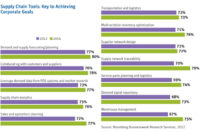Control Management: Extending supply chain visibility

In today's world of food and beverage manufacturing, more product variations, more packaging changes equal more profit-or at least that's what manufacturers and processors hope. The market is moving rapidly from a supply driven to an increasingly regulated demand- and service-driven market. In response, processors must improve all business operations. Food manufacturers must allow for more diversity in their product portfolios, varying and smaller batch sizes, in order to please consumers and customers alike.
For example, packaging production equipment that offers both high changeover efficiency and a wider range of functions provides the flexibility to meet today's demanding business challenges. Using state-of-the-art machinery features, entire lines can be reconfigured for a wide variety of package sizes and shapes, quantity, serialization and quality control. In fact, today's new modular packaging lines can perform functions that previously required several lines.
Yet, with all the benefits come some new challenges. More means more data; data and analysis that should be organized and managed in order to effectively meet your business goals. To meet these challenges, manufacturers should perceive packaging line operations as an information management problem. A line management system should be flexible enough to support information management and line reconfiguration while safeguarding production records.
The right infrastructure
An emphasis on sourcing, manufacturing and delivery of goods with an infrastructure that provides visibility throughout all tiers of the supply chain leads to effective execution. Extending supply chain visibility depends upon a greater reach of information on raw materials in transit, work in process and inventory in warehouses and distribution centers. Organizations are relying upon the capabilities of packaging line operations to ensure that the shipment of the final product has achieved Key Performance Indicator (KPI) targets.KPIs gauge the efficiency of an organization and also ensure that once a product enters the supply chain, the consumer receives a quality product. Optimal performance depends on seamless communication from the top to bottom of the business, enabling rapid response to equipment repairs and informational subsystems that facilitate reconfiguration of entire lines.
ID technology
Product identification and labeling helps create an information-rich environment that improves operational visibility. The food and beverage industry is reaching the point where multiple types of identification technology will be required in a material handling and manufacturing operation.Although bar code technology is the most prevalent marking solution on the market today, the pressure is on to use alternative technologies such as 2D bar code and RFID tags.
So is more better? It can be, if you wisely collect and analyze the information that flows from processing down through packaging and distribution. Data and information management is at the epicenter of improvements in the supply chain. However, accuracy can be enhanced through integration services that encompass both fundamental scanning and labeling systems as well as detailed line management.
Looking for a reprint of this article?
From high-res PDFs to custom plaques, order your copy today!








